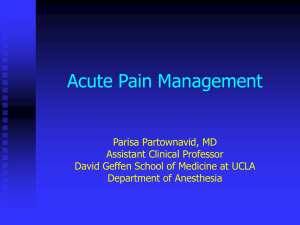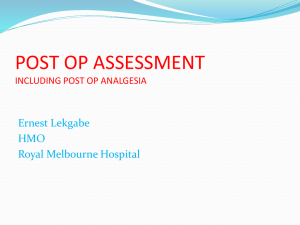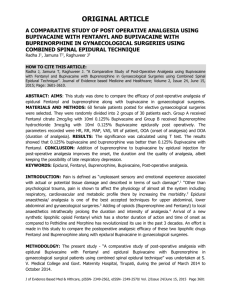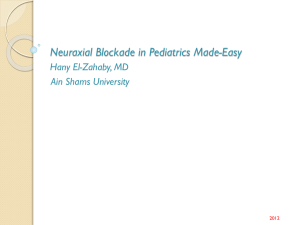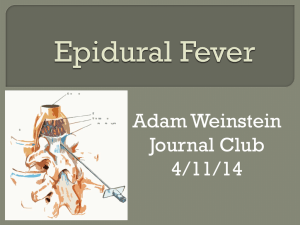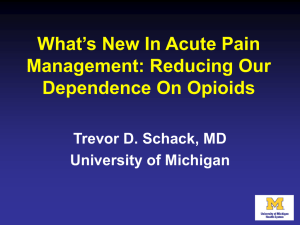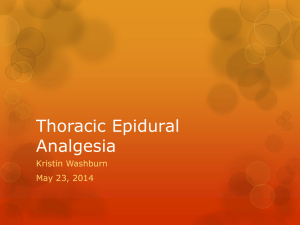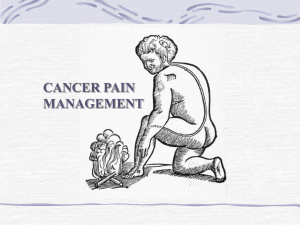Dr Salimi
advertisement
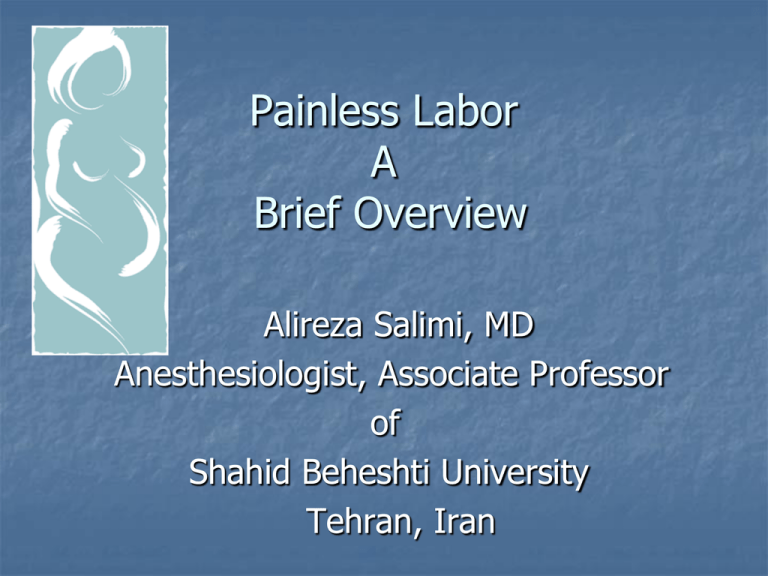
Painless Labor A Brief Overview Alireza Salimi, MD Anesthesiologist, Associate Professor of Shahid Beheshti University Tehran, Iran History The Anatomy and Physiology of Labor Pain METHODS OF PAIN RELIEF IN LABOR History Garden of Eden Original Sin God punished Eve: “In sorrow thou shalt bring forth children.” Genesis 3:16 Formed the basis of 1800 years of opposition to pain relief in labor. 1591 Lady Euframe MacAlyane of Edinburgh, Scotland: was Burned at the Stake because asking for labor analgesia. 1847 History Sir James Young Simpson. Simpson argued persuasively that" sorrow” was improperly translated. 1853 John Snow and Queen Victoria 1855 Religious acceptance. Archbishop of Canterbury's (leader of the Anglican/Episcopal Church) daughter received chloroform for labor pains. He refused to criticize. History August Bier ,…………….., Virginia Apgar ,… 1900 : Oskar Kreis , used spinal anesthesia for childbirth for the first time The Anatomy and Physiology of Labor Pain STAGES OF LABOR I. II. III. From onset of regular uterine contractions to full dilation of cervix. From full cervical dilation to delivery of the fetus. From delivery of the fetus to delivery of the placenta. nerve pathways for labor pain METHODS OF PAIN RELIEF IN LABOR METHODS OF PAIN RELIEF NON-PHARMACOLOGICAL METHODS PHARMACOLOGICAL METHODS NON-PHARMACOLOGICAL METHODS LAMAZE Preparation It is not just a birthing method but a birthing philosophy. A psycho prophylaxis in labor. HYPNOSIS based on the power of suggestion. self-hypnosis or receive assistance from a hypnotherapist. training sessions are required. Many methods are based on the work of Grantly DickRead, MD, NON-PHARMACOLOGICAL METHODS ACUPUNTURE Generally two local points and two distal points on the arms or on the legs are selected. Begin Acupuncture 4 weeks before the expected time of delivery. Needles are placed once a week using the specific points. Points LI.4 Hegu, SP.6 Saninjiao, Extra Neima PC 6 (Neiguan), Du.20,Du.2,Du6, GB.21, He.7(shenmen) TENS Beneficial in patients with moderate to severe contraction pains in an otherwise reasonably normal labor. Very popular in Europe. Easy to apply, non-toxic and frequently effective. 4 electrodes are placed one on either side of the spine in the lower thoracic region (T 10) and one on either side of the spine in the sacral area. The patient may control up to 3 levels of intensity of stimuli, and she can switch it off if she wishes. PHARMACOLOGICAL METHODS Regional Analgesia SPINAL ANALGESIA EPIDURAL ANALGESIA COMBIND SPINAL EPIDURAL CAUDAL PUDENDAL PARACERVICAL Systemic Analgesia Intra Venous Analgesia Inhalational Analgesia Inhalational Analgesia Entonox Isoflurane Enflurane Desflurane (50:50 N2O/O2) ( 0/2%) (0/2%) (0/2%) LIMITED USE Drowsiness ,Unpleasant smell, High cost, Accidental overdose Systemic Analgesia OPIOIDS PETHIDINE (MEPERIDIN) FENTANYL SUFENTANIL REMIFENTANIL MORPHINE PENTAZOCINE NALBUPHINE TRAMADOL SEDATIVE-TRANQUILIZER BENZODIAZPINES BARBITURATE KETAMINE PROMETHAZINE Intravenous Analgesia Ketamine 0.5 to 1 mg/kg every 5 min Remifentanil 0.4 μg /kg lockout 1 min Promethazine 25-50 mg Tramadol 1 mg/kg/Im Active phase, dilatation 3-4cm, fully effaced Chronology of local anesthetics Cocaine Benzocaine Procaine Dibucaine Tetracaine Lidocaine Chloroprocaine Mepivacaine Bupivacaine Niemann Salkowski Einhorn Meischer Eisler Lofgren Marks, Rubin Ekenstam Ekenstam 1860 1895 1904 1925 1928 1943 1949 1956 1957 Ropivacaine Sandberg 1989 levobupivacaine 2000 Ropivacaine , Levobupivacaine or Bupivacaine? Bupivacaine (7575 citations) Ropivacaine (704 citations) Levobupivacaine (69 citations) Less toxic than bupivacaine Probabley as potent as bupivacaine Ropivacaine and levobupivacaine appear to be safer than bupivacaine Intrathecal Analgesia [ITA] The 33 articles selected included 14 studies, 1 metaanalysis, and 2 systematic reviews obstetrics in rural and small urban centers might find single-dose ITN a useful alternative to parenteral or epidural analgesia for appropriately selected patients. A combination of 2.5 mg of bupivacaine, 25 μg of fentanyl, and 250 μg of morphine intrathecally usually provides a 4 hour painless window. CONTINUOUS EPIDURAL The Cochrane Library Date review completed: pre 2004 Number of trials included: 16 Control group: various non-epidural analgesic interventions Main outcomes: pain relief better than cobntrol group Does Epidural Analgesia Increase the Incidence of Cesarean Section? NO Does Epidural analgesia prolong labor ? NO American Journal of Obstetrics and Gynecology 171(5), 1994, 1398 Anesthesiology 80(6), 1201-1208, 1994 American Journal of Obstetrics and Gynecology 185(1), 2001, 182-134 Continues Epidural Test dose : 3 ml of 0.125% Bupivacaine Blouse : 8ml of 0.125% Bupivacaine + 50 μg of Fentanyl. Maintenance: 0.125% Bupivacaine +2 μg /ml Fentanyl at the rate of 10ml/h 3ml/5min P.R.N 3 times for breaking through pain upon patient request RECENT ADVANCES IN LABOR ANALGESIA PATIENT CONTROLLED ANALGESIA EPIDURAL (PCEA) INTRAVENOUS (PCA) COMBINED SPINAL EPIDURAL (CSE) PATIENT CONTROLLED EPIDURAL ANALGESIA PCEA Advantages: 1. Ability to minimize drug dosage 2. Flexibility and benefits of self-administration 3. Reduced demand on professional time PCEA 0.0625% Bupivacaine +Fentanyl 2 μg /ml Demand dose: 3ml , Lockout interval 6 min Background infusion 6 ml/h 3ml/5min P.R.N 3 times for breaking through pain upon patient request PCEA 0.125% Bupivacaine with 1:400,000 Epinephrine Plus Fentanyl 2 μg /ml 2ml bolus /10min lockout interval 3ml bolus/15min lockout interval 4ml bolus/20min lockout interval 6ml bolus/30min lockout interval COMBINED SPINAL EPIDURAL Needle” through “Needle” “ Back “ eye” Needle” through “Needle” technique is the best Can be placed in lateral or sitting position Walking Epidural possible To CSE or not CSE all women in labo(u)r? Advantages of CSE Rapid onset of analgesia Reliable, fewer failed or patchy blocks Effective sacral analgesia in advanced labor Less motor block Better patient satisfaction Aids epidural localization in difficult backs Faster cervical dilation in early nulliparas PROTOCOLS AND COCKTAILS CONTINUOUS EPIDURAL FOR LABOUR (SUGGESTED TECHNIQUE) Placement of epidural catheter Test dose 3ml of lidocaine 1.5% with adrenaline (?) Initial loading dose 10ml of bupivacaine 0.25% or lidocaine 1% and fentanyl 50 μg . CONTINUOUS EPIDURAL FOR LABOR SUGGESTED TECHNIQUE Start the infusion as soon as adequate anesthesia is achieved. Initial infusion rates are - bupivacaine 0.25% 812 ml/hr or lidocaine 0.5% 10-15 ml/hr. Brigham and Women’s Hospital PCEA: 20ml BUP 0.125% + fentanyl 2mcg/ml, then 6 ml/hr infusion, 6ml bolus, 15min lockout CSE: 2.5mg BUP + fentanyl 25mcg No test dose, start PCEA Northwestern PCEA: 0.0625% + 2 mcg/ml fentanyl. 15ml/hr basal infusion, 5ml bolus, 10min lockout, 30ml/hr max. If patient requires manual rebolusing they change to 0.11% BUP CSE: early labor 25mcg fentanyl + test dose Regular labor or multip: 15mcg fentanyl + 2.5mg BUP + test dose. Start PCEA UCSF CSE: 2.5mg BUP + 25mcg fentanyl No test dose Infusion started Ropivacaine 0.1% + SUF 0.5mcg/ml Test dose + 5ml loading dose PCEA: 4ml doses, 20min lockout CEI: 6ml/hr Rescue: 5ml if VAS > 5 Current Policy In Our Hospital No epidural before cervical dilatation of 4 cm No epidural in the second stage IV hydration before/during epidural Bupivacaine 0.0625% ± fentanyl 2μg/ml Infusion rate 8~15 ml/hr ± initial loading 5~10 ml Essentially nurse-control analgesia TIPS Van Gessel et al. demonstrated that 59% of dural punctures were performed 1 or 2 spaces higher than assumed Broadbent et al. demonstrated in a group of experienced anesthesiologists that when they believed they were at L3-L4, in 85% of the cases the space was 1 to as many as 4 segments higher Limitations Complications of Epidural Analgesia Immediate Hypotension Urinary retention Local anestheticinduced convulsions Local anestheticinduced cardiac arrest Delayed Postdural puncture headache Transient backache Epidural abscess or meningitis THANK YOU. Thank you Concentration (%) Dose (mg*segment-1) Onset (min) Duration (min) Chloroprocaine 2-3 45 5-15 30-90 Lidocaine 1-2 25 5-15 60-120 10-20 120-140 Bupivacaine 0.25-0.75 7 Ropivacaine 0.25-.75 9 10-15 120-160 TEŞEKKÜRLER REAL WOMAN REAL PAIN Global year against pain in woman 1847 It was more properly “labor”, “toil”, or “physical exertion”. Noted that God had permitted Adam to sleep when the rib was harvested to create women. Thus, clearly anesthesia was divinely acceptable. Visceral pain comes from outer covering of abdominal viscera which are innervated by autonomic nervous fibres , pain is due to distension or muscular contraction of a viscera It is typically vague , dull and nauseating , percieved in areas corresponding to embryonic dermatome origin Somatic pain comes from parietal peritoneum which are innervated by somatic nervous fibres pain is due to irritation from inflammation ,infection , chemical It is typically sharp and well localised Referred pain is pain percived distant from its source and result from convergence of nerve fibres at spinal cord CAUSES OF ABDOMINAL PAIN DURING PREGNANCY (A) Pregnancy Related Pain: Early pregnancy o Abortion: Inevitable, incomplete or septic abortions o Vesicular mole: when expulsion starts. o Ectopic pregnancy: pain precedes bleeding. Later pregnancy o Braxton-Hicks Contraction o Round Ligament Pain o Pressure symptoms o Cholestasis of pregnancy o Placental abruption o Placenta percreta o Acute Fatty Liver o Pre-eclampsia , HELLP o Spontaneous rupture of the liver o Uterine rupture o Chorioamnionitis o Acute Polyhydramnios o Labor ( Term , Preterm ) (B)Conditions associated with pregnancy • © Non-Pregnancy Related Pain • Gastrointestinal o Acute appendicitis o Peptic ulcer o Gastroenteritis o Hepatitis o Inflammatory Bowel Complication (Crohn’s &Ulcerative Colitis ) o Bowel obstruction o Bowel perforation o Herniation o Meckel diverticulitis o Toxic megacolon o Pancreatic pseudocyst HepatoBliary o Biliary Stones o Acute Hepatitis o Acute Cholecystitis o Acute pancreatitis Rupture of rectus abdominus muscle Torsion of the pregnant uterus Acute urinary retention due to retroverted gravid uterus MusculoSkeletal ( Pubic Symphysis pain-sacroiliac – back pain ) Red degeneration of myoma Torsion of pedunculated myoma Ovarian cyst rupture Adnexal torsion Genitourinary o Ureteral calculus o Acute pyelonephritis o Acute cystitis o Rupture of renal pelvis o Ureteral obstruction Vascular o Superior mesenteric artery syndrome o Thrombosis/infarction - Specifically mesenteric venous thrombosis o Ruptured visceral artery aneurysm Respiratory o Pneumonia Other o Intraperitoneal hemorrhage o Splenic rupture o Abdominal trauma o Acute intermittent porphyria o Diabetic ketoacidosis o Sickle cell disease Braxton Hicks contractions They are sporadic uterine contractions that actually start at about 6 weeks, although women won't be able to feel them that early. they probably won't start to notice them until sometime after midpregnancy, if they notice them at all (some women don't). They get their name from John Braxton Hicks, an English doctor who first described them in 1872. As pregnancy progresses, Braxton Hicks contractions tend to come somewhat more often, but they remain infrequent, irregular, and essentially painless. Sometimes, though, Braxton Hicks are hard to distinguish from early signs of preterm labor By the time within weeks of labor, these contractions may get more intense and more frequent, and cause some discomfort. Unlike the earlier painless and sporadic Braxton Hicks contractions that caused no obvious cervical change, these may help cervix "ripen": gradually soften and efface, and maybe even begin to dilate This period is sometimes referred to as "pre-labor." Delivery Base delivery decisions on obstetric indications The mode of delivery used should also be decided based on obstetric indications. If continuation of the pregnancy is expected to lead to maternal morbidity or mortality, delivery is indicated. If improvement of the maternal condition cannot be expected with delivery, treat the patient with the fetus in utero The prophylactic effect of tocolytics remains unproven in these patients. If used, tocolytics should be administered with care If preterm delivery is likely, glucocorticoids can be administered to the mother to decrease the risk of neonatal complications. Avoid glucocorticoids if the mother is at serious risk for significant infection Labour (term or preterm) The evaluation of all pregnant women with abdominal discomfort must always include uterine contractions as an etiology. Pain from labor is generally intermittent, occurring at decreasing intervals. However, tetanic uterine contractions, often evidence of uterine irritability, may produce sustained pain. An accurate estimation of gestational age is crucial to distinguish the normal labor anticipated in a term pregnancy from preterm labor. Preterm contractions are contractions that are painful and occur by definition before 37 weeks of gestational age; preterm labor is defined as preterm contractions with associated cervical change. When contractions are suspected as a cause of abdominal pain, a cervical examination should be performed to evaluate the cervix for dilation, effacement, and if possible the station of the presenting part. A digital cervical examination should not be performed in the face of vaginal bleeding if placenta previa has not been ruled out Patients who are at less than 37 weeks' gestation with suspected preterm rupture of membranes should have a sterile speculum examination performed to confirm membrane rupture and to visually assess cervical dilation, because digital examinations may increase the risk of ascending infection. While the majority of preterm labor is idiopathic, the clinician should remember that there are many conditions that may cause preterm uterine contractions and preterm labor, including placental abruption, chorioamnionitis, trauma, appendicitis, and pyelonephritis or other infection. Rapid evaluation is essential as tocolysis or other obstetric interventions may be indicated depending on gestational age False labour pain ( Late Braxton Hicks contractions ) Irregular, Not progressively increasing Not associated with bulging of forebag of water or dilatation of the cervix. Respond to anlgesics Cause women confusion as to whether or not they were going into actual labor. They are thought to be part of the process of effacement, the thinning and dilation of the cervix Round Ligament Pain with advancing gestational age as the uterine size increases. The round ligaments, found on the right and left sides of the uterus, attach to the pubic bone and help support the placement of the uterus in the abdominal cavity. these ligaments endure continual stretching and are a common source of pain in the latter part of pregnancy. Pain, either a sharp spasm or dull ache continuous, and may be described as a stretching or pulling sensation, is felt on one, or sometimes both, sides of the lower abdomen , often described as "round ligament pain"; however the exact origin of this pain many vary from patient to patient. This pain may be relieved by heat or acetaminophen, It is a benign and usually self-limiting occurrence that commonly causes discomfort in the second trimester DEFINITION OF LABOUR ‘LABOUR can be defined as spontaneous painful uterine contractions associated with the effacement and dilatation of the cervix and the descent of the presenting part’ CONSEQUENCES OF PAIN IN LABOUR Pain is a noxious and unpleasant stimulus—produces fear and anxiety. Unrelieved stress in labour produces increased plasma cortisol and catecholamine concentrations. Leads to reduction in utero-placental blood flow. Effective pain relief reduces plasma nor-adrenaline, prevents the rise during first & second stage of labour. Prevents metabolic acidosis by reducing the rate of rise of lactate and pyruvate. Decreases maternal O2 consumption by 14%. WHY PAIN OCCURS DURING LABOUR? First stage pain is due to uterine contractions causing stretching, tearing and possibly ischaemia of the uterus and dilatation of the cervix. Second stage pain is caused by distension of pelvic structures and perineum following descent of the presenting part. Potential adverse effects of pain on the foetus POSITION OF TENS ELECTRODES Mechanism of action: Inhibits transmitter release along pain pathway by stimulating the myelinated Aβ fibres of the spinal nerve roots T10-L1 & S2-4. Neuronal release of Endorphins in to the CSF may result in a feeling of well being as well as analgesia. DECOMPRESSION SUIT A rigid shell or light cage covered with polythene was sealed over lower chest,abdomen and thighs. Electrically operated suction device-Generates a negative pressure of 20-159 mm Hg inside the shell. Disadvantages: 1. Equipment is expensive & cumbersome. 2. The electric motor used to generate the suction is noisy. 3. Shell limits the fetal monitoring. 4. Mother has to be in supine position. IDENTIFICATION OF EPIDURAL SPACE CAUSES OF NEGATIVE PRESSURE IN EPIDURAL SPACE Negative pressure exists in only 80% of patients. Possible causes Dimpling of dura by needle. Transfer of negative pressure from thorax via paravertebral spaces. Full flexion of back. PARACERVICAL BLOCK Usually performed by obstetrician Blocks the visceral afferent nerve fibres that pass through the paracervical ganglion of Frankenhauser Gives good analgesia without motor blockade Does not block the progress of labour Disadvantages: Does not provide perineal analgesia High incidence of fetal bradycardia-due to high levels of local anesthetic entering the uterine artery and reaching the fetus Trauma to fetal scalp or maternal vagina. FETAL EFFECTS Indirectly by changes in uterine blood flow Effect exerted directly by local anesthetic drugs Changes in uterine contractility Epidural blockade-produces fall in fetal oxygenation-if hypotension is allowed to develop If MAP remains<70mmHg for more than 3 hrs-neonatal neuro – behaviour will be impaired. PUDENTAL NERVE BLOCK Usually performed by obstetrician Provides good analgesia for somatic perineal pain in the second stage of labour. Disadvantages: Trauma to mother & fetus Accidental intravascular injection into the adjacent pudental vessels Vaginal & ischiorectal haematoma Retropsoal & subgluteal abscess. INHALATIONAL ANALGESIA N2O does not interfere with uterine contractions. No effect on fetus too. Premixed nitrous oxide &oxygen. N2O 50% and O2 50%. ENTONOX-cylinders with a capacity of 500 L are available. Inhalation should begin 45 seconds before the onset of pain. If the patient holds her mask -it will fall from her hand, should unconsciousness supervene . (safety factor) NON-PHARMACOLOGICAL METHODS ADVANTAGES—Drugs administered may cross the placenta and depress the fetus. Any method that avoids or restricts their use deserves attention. CONTRAINDICATIONS A.ABSOLUTE Maternal refusal Coagulation disorders Local sepsis Patient on anti-coagulant therapy B.RELATIVE Shock Hypovolaemia Neurological disease Previous spine surgery Difficult anatomy C.MISCELLANEOUS Inexperienced anesthetist Inadequate supervision, facilities, apparatus and personnel Very obese patients Allergies to local anesthetic drugs COMPLICATIONS A.MATERNAL Needle or catheter-insertion Wrong place Penetrates blood vessels,dura,neural tissue. Broken catheter. Injection Sub-arachnoid Intravascular Adverse reaction to local anesthetics Neural blockade Hypotension Motor blockade Bladder dysfunction Shivering. COMPLICATIONS……… Inadequate Anaesthesia Total failure Partial failure Progress of labour Prolongs labour Increased instrumental deliveries. MATERNAL COMPLICATIONS 1. 2. 3. 1. 2. 3. A. BLOODY TAP: Epidural venous plexuses are distended during pregnancy. Accidental intravenous injection causes— Hypotension Convulsions Unconsciousness. B. DURAL PUNCTURE: Incidence-13% (in the hands of inexperienced anesthetist) Sequelae of dural puncture PDPH Sub-dural or extradural haematoma Total spinal block. Delayed Complications NEUROLOGICAL Injury to peripheral nerves Femoral & common peroneal nerve HEADACHE- Post-dural puncture headache (PDPH). NON-PHARMACOLOGICAL METHODS AROMA THERAPY AUDIO ANALGESIA WATER BIRTH WATER BATHS RECENT ADVANCES IN LABOUR ANALGESIA Newer drugs for epidural: Sufentanil---- potent opioid Levobupivacaine—less motor blockade Ropivacaine----- less motor blockade RECENT ADVANCES IN LABOUR ANALGESIA Walking epidurals Increased maternal comfort Improved neonatal outcome Ability to walk & change positions in bed are supporting reasons for walking epidurals. CONTINUOUS SPINAL ANALGESIA Using micro catheters--- 28 G. REGIONAL ANALGESIA A. Sympathetic From T 6- L 2. Motor to upper uterine segment via splanchnic nerves & coeliac, aortic, renal &hypogastric plexuses and then to great cervical ganglion of Frankenhauser. B. Visceral afferent T 11-L 1 Sensory from uterus Block of these eases pain of first stage of labour. C. Visceral afferent & efferent Parasympathetic Sensory and Motor to cervix Inhibitory to uterus S2,3,4. Does Epidural Analgesia Increase the Incidence of Cesarean Section? American Journal of Obstetrics and Gynecology 171(5), 1994, 1398 Does Early Administration of Epidural Analgesia Affect Obstetric Outcome in Nulliparous Women Who Are in Spontaneous Labor? Anesthesiology 80(6), 1201-1208, 1994 Does epidural analgesia prolong labor and increase risk of cesarean delivery? American Journal of Obstetrics and Gynecology 185(1), 2001, 182-134 Loading dose: 11ml Ropivacaine 0.2% Maintenance: 6ml/h Ropivacaine 0.1% plus Fentanyl 2 μg /ml Demand dose of 5ml,lockout interval 10min Maximum 31ml Cleveland Epidural initiated: 8 ml 0.25% BUP 0.125% BUP PECA: 4 ml basal, 4 ml bolus, Lockout 20 min, 16 ml/hr max CIEA: 12 ml/hr infusion


